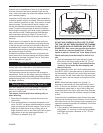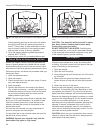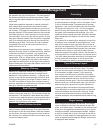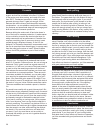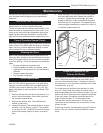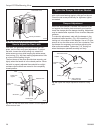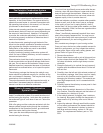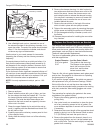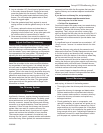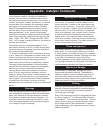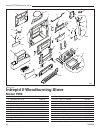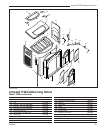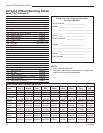
31
Intrepid II Woodburning Stove
2000966
5. Lay an unbroken 1/8” (3mm) bead of gasket cement
in the newly-cleaned channel. Starting at one end,
press the gasket into the channel. Ensure a good
joint where the gasket meets before trimming any
excess. Do not overlap the gasket ends or leave
ends with ragged edges.
6. Press the gasketed part firmly against its normal
mating surface to seat the gasket evenly in its chan-
nel.
7. For doors, replace the doors and close them on
a piece of waxed paper to keep the cement from
migrating onto the stove front, or tap other parts with
the rubber mallet (or hammer/block of wood).
8. Clean excess cement from around the channel. Let
the cement that holds the new gasket dry thoroughly.
Adjust the Door if Necessary
The door latch or damper mechanism may need adjust-
ment after you have regasketed them. Initially, it may
require loosening to accommodate the new gasket; af-
ter a few weeks, it may need tightening to compensate
for compression of the new gasket. The directions for
adjusting the latch and damper are on Page 27.
Permanent Gaskets
Other gaskets seal between non-moving parts, but
these are not subject to the same wear and deteriora-
tion as gaskets on moving parts. It is unlikely that you
will ever need to replace these gaskets unless the
involved parts are disassembled and then put back
together. If this is the case, the job should be done only
by a qualified service technician. The diameter of the
gasket that seals these non-moving parts is 5/16”, and
the areas sealed are the flue collar to the stove back;
and the lower fireback to the sides. The glass panels
use a special die-cut flat gasket; refer to Page 24 for
information on these.
The Chimney System
Creosote
Your Intrepid II is designed to reduce creosote buildup
significantly. However, regular chimney inspection and
maintenance must still be performed. For safety, good
stove performance, and to protect your chimney and
chimney connector, inspect the chimney and chimney
connector on a regular schedule. Clean the system if
necessary. Failure to keep the chimney and connector
system clean can result in a serious chimney fire.
When wood is burned slowly, it produces tar, organic
vapors and moisture that combine to form creosote.
The creosote vapors condense in the relatively cool
chimney flue. As a result, creosote residue accumulates
on the flue lining. When ignited, this creosote makes an
extremely hot fire within the flue system that can dam
-
age the chimney and overheat adjacent combustible
material.
If you do have a chimney fire, act promptly to:
• Close the damper and thermostat lever.
• Get everyone out of the house.
• Call the Fire department.
You should inspect the system every two weeks during
the heating season as part of a regular maintenance
schedule. To inspect the chimney, let the stove cool
completely. Then, using a mirror and a strong light,
sight up through the flue collar into the chimney flue. If it
is not possible to inspect the flue system in this fashion
the stove must be disconnected to provide better view-
ing access.
If a significant layer of creosote has accumulated - 1/8”
(3mm) or more - remove it to reduce the risk of a chim-
ney fire.
Clean the chimney using a brush the same size and
shape as the flue liner. Flexible fiberglass rods are used
to run the brush up and down the liner, causing any
deposits to fall to the bottom of the chimney where they
can be removed through the clean out door.
The chimney connector should be cleaned by discon-
necting the sections, taking them outside, and removing
any deposits with a stiff wire brush. Reinstall the con-
nector sections after cleaning, being sure to secure the
individual sections with sheet metal screws.
If you cannot inspect or clean the chimney yourself,
contact your local Vermont Castings authorized dealer
or hire a professional chimney sweep.
Annual Maintenance
Perform a thorough cleaning, inspection and repair
each spring, at the end of the heating season.
• Thoroughly clean the chimney and chimney connec-
tor.
• Inspect the chimney for damage and deterioration.
Replace weak sections of prefabricated chimney.
Have a mason make repairs to a masonry chimney.
• Inspect the chimney connector and replace any
damaged sections.
• Check gasketing for wear or compression, and
replace if necessary. A ‘paper test’ will guide you on
this. Close and lock the door or damper on a slip of
paper and then try to pull the paper out. If the paper
pulls out with little or no resistance, the gasket is not
snug enough at that spot. If adjusting the damper or
latch does not result in a seal that makes it hard to
pull the paper out, replace the gasketing.



